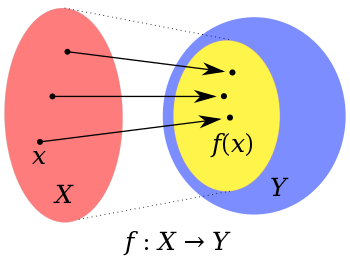Range of a function
In mathematics, the range of a function may refer to either of two closely related concepts:
Terminology
As the term "range" can have different meanings, it is considered a good practice to define it the first time it is used in a textbook or article. Older books, when they use the word "range", tend to use it to mean what is now called the codomain.[1][2] More modern books, if they use the word "range" at all, generally use it to mean what is now called the image.[3] To avoid any confusion, a number of modern books don't use the word "range" at all.[4]
Elaboration and example
Given a function
with domain , the range of may refer to the codomain or target set (the set into which all of the output of is constrained to fall) or to , the image of the domain of under (the subset of consisting of all actual outputs of ). The image of a function is always a subset of the codomain of the function.
As an example of the two different usages, consider the function as it is used in real analysis, that is, as a function that inputs a real number and outputs its square. In this case, its codomain is the set of real numbers , but its image is the set of non-negative real numbers , since is never negative if is real. For this function, if we use "range" to mean codomain, it refers to . When we use "range" to mean image, it refers to .
The image and the codomain can coincide. Consider the function , which inputs a real number and outputs its double. For this function, the codomain and the image are the same (the function is a surjection), so the word range is unambiguous; it is the set of all real numbers.
See also
Notes
- Hungerford 1974, page 3.
- Childs 1990, page 140.
- Dummit and Foote 2004, page 2.
- Rudin 1991, page 99.
References
- Childs (2009). A Concrete Introduction to Higher Algebra. Undergraduate Texts in Mathematics (3rd ed.). Springer. ISBN 978-0-387-74527-5. OCLC 173498962.
- Dummit, David S.; Foote, Richard M. (2004). Abstract Algebra (3rd ed.). Wiley. ISBN 978-0-471-43334-7. OCLC 52559229.
- Hungerford, Thomas W. (1974). Algebra. Graduate Texts in Mathematics. 73. Springer. ISBN 0-387-90518-9. OCLC 703268.
- Rudin, Walter (1991). Functional Analysis (2nd ed.). McGraw Hill. ISBN 0-07-054236-8.
